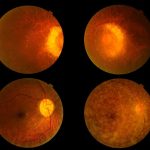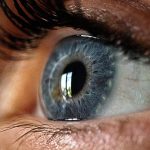The National Eye Institute designates the month of February as Low Vision Awareness Month in order to increase awareness about this visual impairment condition. It’s estimated that more than 3 million Americans age 40 and older are experiencing low vision, which can significantly affect their productivity, functionality, and overall enjoyment of life.
What is Low Vision?
Low Vision is a condition where a person’s vision is impaired so dramatically that it cannot be corrected or improved any further with prescription lenses, medication or surgery.
People with severe Low Vision have an extreme visual impairment – about 20/200 or worse as measured on the scale where ideal visual acuity is 20/20. That means that people with severe Low Vision can’t read the top line of an eye chart from 20 feet away (and yes, we’re talking about the largest letter at the top of the chart).
Below, we explore the seven leading causes of Low Vision. Are you at risk?
- Age-related Macular Degeneration (AMD). The leading cause of blindness in Americans over age 50, AMD is an age-related condition in which the macula—the center of your eye’s retina—deteriorates. The retina has millions of light-sensitive cells that perceive vision, and its center is called the macula. When you lose the ability to process vision in that central area, you can no longer perform fine-detail tasks, including reading, driving, or sometimes even recognizing the faces of loved ones. It’s like having a blind spot directly in front of you, while peripheral vision often remains. It’s a devastating diagnosis, but when caught early, medication can help slow its progression.
- Glaucoma, known as the “silent thief of sight” because it doesn’t have noticeable symptoms. Once a person notices a loss of vision due to glaucoma, it’s too late to get that vision back. Glaucoma damages the optic nerve because of internal fluid buildup and high fluid pressure inside of the eye. Over time, this high intra-ocular pressure gradually causes vision loss in patches, often starting with peripheral vision loss. Glaucoma ranks as the second-most common cause of blindness in the U.S. When diagnosed early during your annual optometric exam, glaucoma can often be controlled through medication or surgery to slow your rate of vision loss.
- Diabetic Retinopathy, diagnosed in up to 45% of people experiencing diabetes, impacts vision by causing gradual retinal damage that can eventually lead to total blindness if not treated. The best way to prevent diabetic retinopathy is to carefully control your diabetes and monitor blood sugar levels. High blood sugar levels are known to damage blood vessels throughout the body, including the tiny blood vessels in your eyes. When these tiny capillaries leak blood into the eye, the retina swells, resulting in clouded or blurry vision. Controlling blood sugar is critical to minimizing damage to the eyes. There are also laser and surgical procedures that can help slow its progression.
- Retinitis Pigmentosa (RP). Retinitis Pigmentosa is a group of eye diseases that progressively destroy both the peripheral (side vision) and night vision. These diseases damage the rods and cones in the retina, which are the light-sensitive cells. RP has a genetic component and is often inherited, so knowing whether you have a family history of this disease is critical. Its first symptom is often night blindness, and can affect people as young as their teenage or early adult years. Prognosis isn’t good: RP patients typically progress to total blindness around age 40.
- Amblyopia is sometimes called “lazy eye” and usually develops in youth, before the age of 6. Not due to any specific eye health issue, amblyopia occurs when one eye doesn’t develop its central vision normally. This can happen when one eye is weaker and simply doesn’t develop strong visual acuity. The good thing about amblyopia: When it’s caught early, it can be corrected and reversed. That’s why it’s critical to take children to an optometrist for a comprehensive eye exam when they’re babies (at age 6 months) and again at age 3. The bad thing about amblyopia: When it’s not diagnosed and treated until adulthood, it can be nearly impossible to reverse or improve the condition.
- Traumatic Brain Injury. Accidents, blunt force trauma, blows to the head and strokes can result in brain injuries. This can cause blurry vision, permanent changes to your visual field, eye misalignment, problems with depth perception, sensitivity to glare and a significant reduction in visual acuity.
- Cataracts—a clouding of the eye’s natural lens that reduces the amount of light that reaches the retina—are a cause of low vision. However, in most cases, cataracts are operable and can be removed through surgery and replaced with a lens implant that fully restores vision. Caused by lifelong exposure to the sun’s ultraviolet rays, or sometimes caused by injury or a genetic predisposition to the condition, cataracts typically occur as we age into our 60s and 70s. In cases where the eye isn’t healthy enough to undergo surgery or for patients with additional diseases of the eye, cataract surgery may not be possible, and the condition will cause low vision.
Low Vision is typically age-related, becoming more common in adults age 45 and over, and is significantly more common by age 75 when one in 6 people experience low vision.
An annual comprehensive eye exam is your best defense against Low Vision. Many of the conditions that cause it can be controlled or slowed by interventional treatment when diagnosed early. If you haven’t scheduled your annual eye exam, call us today!






